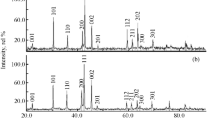Abstract
Multicomponent intermetallic absorbers of hydrogen which are used as active materials in secondary current sources have a number of shortcomings: low electrical capacity and excessively high cost, particularly for cobalt containing alloys. A contemporary progressive method to improve the properties of electrode material is optimization of the alloy microstructure. Intermetallic hydrogen absorbers with controlled structural disorder were obtained by powder metallurgy techniques, and the effect of such on the electrochemical properties examined.
Similar content being viewed by others
REFERENCES
Yu. M. Solonin, L. L. Kolomiets, S. M. Solonin, and V. V. Skorokhod, “Development of hydrogenating powder alloys for the electrodes of alkali batteries. I. Principles of preparing alloys that reversibly absorb hydrogen,” Poroshk. Metall., Nos. 7–8, 53–60 (2003).
J. J. G. Willems and K. H. J. Bushow, “From permanent magnets to rechargeable hydride electrodes,” J. Less Common Metals, 129, No. 1, 13–30 (1987).
E. Yagasaki, N. Kanda, and K. Mitsuyasu, Rechargeable Electrochemical Cell with Negative Electrode Comprising Hydrogen Absorbing Alloy Including Rare Earth, Pat. A2–0206776 EP, Publ. October 30 (1986).
P. H. L. Notten, R. E. F. Einerhand, and J. L. C. Daams, “Non-stoichiometric hydride forming compounds,” Z. Physikal. Chem., 183, 267–279 (1994).
J. Mossinger and M. Hirscher, “Influence of microstructure on short-range and long-range diffusion processes of hydrogen in transition metal alloys,” Z. Physikal. Chem., 183, 13–21 (1994).
J. Keem, R. Bergeron, R. Custer, and R. McCallum, Electrodes Made with Disordered Active Material and Methods of Making the Same, Pat. Al-4637967 US, Publ. January 20 (1987).
K. Sapru, B. Reichman, A. Reger, and S. Vshinsky, Rechargeable Battery and Electrode Used Therein, Pat. Al-4623597 US, Publ. November 18 (1986)
Author information
Authors and Affiliations
Corresponding author
Rights and permissions
About this article
Cite this article
Solonin, Y.M., Kolomiets, L.L., Solonin, S.M. et al. Development of Hydrogenating Powder Alloys for the Electrodes of Alkali Batteries. Part 2. Structural Disorder in Hydriding Alloys as the Basis for Increasing the Cyclical Stability of Metal Hydride Electrodes. Powder Metallurgy and Metal Ceramics 42, 491–496 (2003). https://doi.org/10.1023/B:PMMC.0000013221.17735.b1
Issue Date:
DOI: https://doi.org/10.1023/B:PMMC.0000013221.17735.b1




